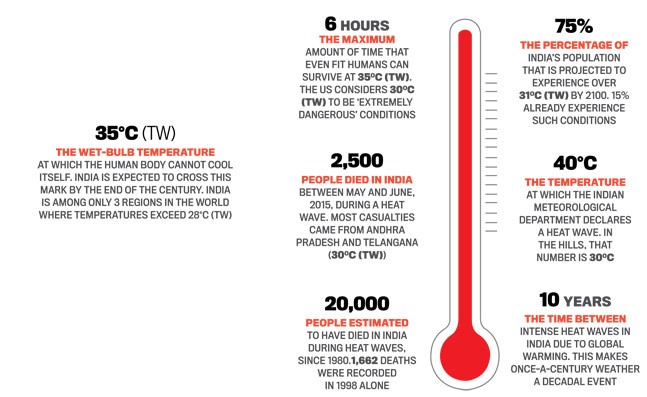Heatwaves: India
(→Delhi) |
(→2021: unusual pattern) |
||
| Line 122: | Line 122: | ||
R.K Jenamani, scientist at IMD, said several western disturbances in April and May did not allow temperatures to rise significantly. “Generally, one gets 3-5 western disturbances in a month, but April and May saw even up to 11 in a month, which brought regular rainfall over the northern plains. Due to this, the maximum temperature hardly crossed 42 degrees Celsius,” said Jenamani, adding that even when the monsoon arrives at Juneend, it is generally weak and heatwave days in late June or early July aren’t so uncommon. | R.K Jenamani, scientist at IMD, said several western disturbances in April and May did not allow temperatures to rise significantly. “Generally, one gets 3-5 western disturbances in a month, but April and May saw even up to 11 in a month, which brought regular rainfall over the northern plains. Due to this, the maximum temperature hardly crossed 42 degrees Celsius,” said Jenamani, adding that even when the monsoon arrives at Juneend, it is generally weak and heatwave days in late June or early July aren’t so uncommon. | ||
| + | |||
| + | |||
| + | ==2022, till mid-June== | ||
| + | ===Delhi: Heatwave days, , till mid-June === | ||
| + | [https://epaper.timesgroup.com/article-share?article=14_06_2022_004_003_cap_TOI Priyangi Agarwal, June 14, 2022: ''The Times of India''] | ||
| + | |||
| + | [[File: Heatwave in Delhi- Safdarjung, 2022.jpg|Heatwave in Delhi- Safdarjung, 2022 <br/> From: [https://epaper.timesgroup.com/article-share?article=14_06_2022_004_003_cap_TOI Priyangi Agarwal, June 14, 2022: ''The Times of India'']|frame|500px]] | ||
| + | |||
| + | |||
| + | New Delhi: Safdarjung witnessed 26 days when the maximum temperature was 42 degrees or more between March 1 and June 13. This is the highest number of such days in the past 10 years. Safdarjung, the city’s base weather station, saw 30 such days in 2012.
According to India Meteorological Department, the normal temperature for March, April, May and June for Safdarjung is 29. 6, 36. 3, 39. 5 and 39. 2 degrees Celsius, respectively. An official said a temperature of above 40 degrees Celsius raises discomfort.
Data from the Met department shows that just six and three such days were recorded in 2021 and 2020, respectively, between March 1 and June 30 when the maximum temperature was 42 degrees Celsius and above. No such day was reported in 1953, 1954 and 1971. IMD said the summer of 2010 saw the highest number of such days (35).
The capital recorded six spells of heatwave this year. RK Jenamani, senior scientist, IMD, said, “Summer 2022 in northwest India, including Delhi, uniquely started and progressed. As no significant rain was recorded from the last week of February till May 20, it led to dry conditions, resulting in frequent days with high temperature. ” | ||
| + | |||
| + | “Two active western distur- bances hit north India from May 22 to 30, giving respite from heatwave conditions. Rain helped surpass the normal mark of rainfall for the entire month of May. However, dry spell has again continued from June 1. The maximum temperature at Safdarjung has been above 42 degrees Celsius since June 3. The prolonged heatwave has affected people, plants and animals,” added Jenamani. | ||
| + | |||
| + | A major respite from heatwave conditions is expected on June 16-17. “The ongoing heatwave spell, which began from June 2, may be the last major one of this season. | ||
| + | From June 16, heatwave is predicted to abate from northwest and central India, including Delhi-NCR. Pre-monsoon showers are expected from this week, which may bring down the temperature to below 40 degrees Celsius by June 16-17,” Jenamani said. | ||
| + | |||
| + | IMD has forecast the maximum temperature to be around 39 degrees Celsius on June 17, which may come down to 36 degrees Celsius on June 19. The maximum and minimum temperatures on Monday at Safdarjung was reported at 43. 7 and 31. 6 degrees Celsius, respectively. Both temperatures were four degrees above normal. | ||
[[Category:Climate/Meteorology|H HEATWAVES: INDIAHEATWAVES: INDIAHEATWAVES: INDIAHEATWAVES: INDIA | [[Category:Climate/Meteorology|H HEATWAVES: INDIAHEATWAVES: INDIAHEATWAVES: INDIAHEATWAVES: INDIA | ||
Revision as of 18:40, 25 June 2022
This is a collection of articles archived for the excellence of their content. |
Contents |
Heatwave: One word or two?
Oxford Dictionaries spell heatwave as one word, and provide this illustration:
‘when a heatwave occurs many people become increasingly bad-tempered’
In Australia, too, it is one word.
Among major dictionaries Cambridge English Dictionary, Collins English Dictionary and Macmillan Dictionary, too, spell heatwave as one word. Only Merriam-Webster spells it as two.
In large areas, a heat wave is declared when the maximum temperature is 45 degrees Celsius for two consecutive days and a severe heat wave is when the mercury touches the 47 degrees-mark for two days on the trot.
In small areas like Delhi, heat wave is declared if the temperature soars to 45 degrees Celsius even for a day, according to the India Meteorological Department (IMD).
Definition
The IMD defines a heatwave day when the maximum is 4.5°C or more above the normal temperature and the maximum is at least 40°C.
A heatwave is also declared if the maximum touches 45°C or above.
A ‘severe heatwave’ is declared when the maximum is 6.5°C or more above normal
The number of heatwave days in a year
2011-20; 21

From: Priyangi Agarwal & Jasjeev Gandhiok, July 10, 2021: The Times of India
See graphic:
The total number of Heatwave days in the Delhi region, 2011-20; 21
2001-16
The Times of India, May 21 2016
Jayashree Nandi
Rajasthan's Phalodi recorded the country's highest temperature ever of 51°C. The India Meteorological Department has said the frequency of severe heatwaves had increased sharply in the past 15 years.
Most heat-affected states have no plan in place to prevent mortality and morbidity associated with extreme heat. IMD officials said the average frequency of severe heat waves had doubled from 50 days a year across India until 2000, to about 100 in the 2001-2010 decade. The figures are cumulative numbers from all IMD stations. So, if there are 10 severe heat wave days in two cities simultaneously, it's counted as 20.
“The frequency of both heatwaves and severe heatwaves has increased, particularly in the last two decades. The reasons could be related to climate change, urban heat island effect or others,“ said B P Yadav, director, National Weather Forecasting Centre at IMD.
He added that between 2010 and 2016 too, heatwaves showed an upward trend.IMD has started issuing a separate colour-coded heat wave forecasting from this year, which alerts agencies on when interventions are required, because of what it called a “visible increase“ in both mean temperature and heat wave incidents.
IMD's observations correlate with warnings by the Intergovernmental Panel on Climate Change (IPCC) of a steady increase in warm days and nights globally, and higher temperatures in cities due to the urban heat island effect.
The Indian Institute of Public Health (IIPH), which has developed a heat action plan for Ahmedabad and helped cities in Maharashtra develop theirs, has advised the Union health ministry to ensure that similar plans are implemented in all states affected by heatwaves.
As of now Maharashtra, Gujarat, Telangana and Andhra Pradesh have started a heat action plan.
“Mortality increases as soon as there is a heatwave.For instance, on Thursday when it recorded 48 degrees in Ahmedabad, there were 130 deaths compared to 100 deaths daily on an average.During the 2010 heat wave, there were 310 deaths in a day and about 800 deaths in total in the following week,“ said Dr Dileep Mavalankar, director, IIPH, Gandhinagar.
“Since the frequency of heatwaves is increasing due to climate change, we have been pursuing the implementation of heat plans with the government. Ideally local government administration or municipalities should be in charge of it,“ Mavalankar said.
2011- 2021 June
Jasjeev Gandhiok & Priyangi Agarwal, June 17, 2021: The Times of India
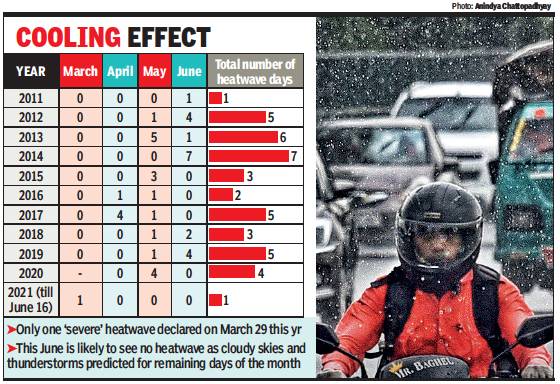
From: Jasjeev Gandhiok & Priyangi Agarwal, June 17, 2021: The Times of India
Delhi has had comparatively salubrious weather this year, with only a single heatwave day so far — the fewest since 2011 when one heatwave day was recorded between March and June. This year too, the only heatwave day recorded was on March 29. With the rainy season around the corner, meteorological officials say another heatwave day is unlikely now in 2021.
A heatwave, in India Meteorological Department definition, is when the maximum temperature is at least 40 degrees Celsius and 4.5 degrees or more higher than normal temperature or the maximum touches 45 degrees Celsius in a meteorological region. The data shows that March 29 recorded 40.1 degrees Celsius, eight degrees above normal. After IMD classified this as a ‘severe’ heatwave day, Delhi hasn’t logged another heatwave day since. In April, the highest maximum recorded was 42.2 degrees Celsius on April 28, four above normal. May was even cooler, with the highest touching just 41.6 degrees Celsius.
IMD data shows the mean maximum temperature for June is 37.5 degrees Celsius, two below the monthly normal of 39.5 degrees. So far, the warmest day has been 42.2 degrees Celsius on June 9. Earlier on May 19, under the influence of Cyclone Tauktae, the city recorded the highest ever single-day rainfall for the month of May. The impact of Cyclone Yaas then helped keep the mercury level from rising. Normal temperatures in May and June touch 43-44 degrees Celsius, with 45.6 degrees in 2019 being the maximum.
Last year, four heatwave days were recorded in Delhi, five in 2019, three in 2018, five in 2017 and two in 2016. The highest number of heatwave days recorded in Delhi in the last decade was seven in 2014.
Kuldeep Srivastava, scientist at IMD and head of the Regional Weather Forecasting Centre, said, “In Delhi, most of the heatwaves days occur in April, May and first week of June. However, not a single heatwave hit the city from April onwards this year because of a series of western disturbances and cloudiness. Also, the maximum temperature this year has not reached the peaks of earlier years.”
Srivastava added, “Delhi is now seeing pre-monsoon activities, including thunderstorms and cloudiness, and monsoon is imminent. It is, therefore, unlikely that there will be heatwave day in the second-half of June.”
IMD data analysed by the Council on Energy, Environment and Water (CEEW) confirmed Delhi’s maximum temperature in May this year was the lowest in the last 70 years. "The summer of 2021 got rare relief from heatwaves because of over five western disturbances and cyclone Tauktae,” pointed out Abinash Mohanty, programme lead, CEEW. “Delhi recorded below normal maximum temperatures and increased wet spells, with more than 60mm of single-day rainfall during a spell. This, coupled with the string of western disturbances, hindered the rise of mercury in NCR. This will also influence the intensity and onset of the monsoon.”
2017
India Today , The heat is on “India Today” 11/9/2017
A study published this month in Science Advances, an American journal, shows that by the end of the century large parts of India may become uninhabitable due to a combination of heat and humidity. The study examined data based on rising wet-bulb temperatures (TW), a measure of the air temperature combined with humidity, to account for relatively cool days that feel hotter because of high humidity. Once a certain wet-bulb temperature is exceeded, the body can no longer cool itself. According to the study, at these temperatures, "exposure, for even a few hours will result in death even for the fittest of humans under shaded, well-ventilated conditions".
2021: unusual pattern
Priyangi Agarwal & Jasjeev Gandhiok, July 10, 2021: The Times of India
Heatwave conditions usually abate in the Delhi region by mid-June. This year, however, there were seven heatwave days in the latter part of June and early July, when usually there is pre-monsoon weather activity. The city did not record a single heatwave day in April and May and just one in Marchend. But the eight heatwave days recorded this year are the highest in the last seven years. Experts attribute the heatwave to lack of rain in June and July.
India Meteorological Department defines a heatwave day as one with when the maximum temperature is 4.5 degrees above the normal and the maximum is at least 40 degrees Celsius. A heatwave also occurs when the maximum temperature touches 45 degrees Celsius. A severe heatwave is declared when the maximum is 6.5 degrees and more above normal.
In Delhi, most of the heatwave days occur in April, May and the first week of June. However, this year not a single heatwave day was recorded between April and the first half of June. A severe heatwave day swept the capital all the way back in March, again unusual for that time of the year.
“A series of western disturbances and two cyclonic storms — Cyclone Tauktae and Cyclone Yaas — helped keep the mercury in check,” said a Met official. “Under the influence of Cyclone Tauktae, the city also recorded the highest single-day ever rainfall in May. Delhi saw thunderstorms and cloudiness on most days from April to mid-June and the temperatures mostly remained below the normal-mark.”
In July, the capital has recorded five heatwave days so far, the most in nine years, just short of the seven in July 2012. As IMD’s forecast says the onset of monsoon over Delhi is likely to happen soon, another heatwave is unlikely this year.
Abinash Mohanty, programme lead, Council on Energy, Environment and Water (CEEW), says the 2021 summer will be seen as one of anomalies, characterised by consecutive heatwave days and increased wetbulb temperatures at June-end and early July. Mohanty explained, “The delayed onset of monsoon due to a complex interaction of westerly winds with moisture carrying easterly winds impacting the weather patterns and micro-climate. Globally, the rise in wet-bulb temperatures has led to mass mortality and can have severe repercussions on human health and productivity, industrial revenue and agricultural productivity.”
R.K Jenamani, scientist at IMD, said several western disturbances in April and May did not allow temperatures to rise significantly. “Generally, one gets 3-5 western disturbances in a month, but April and May saw even up to 11 in a month, which brought regular rainfall over the northern plains. Due to this, the maximum temperature hardly crossed 42 degrees Celsius,” said Jenamani, adding that even when the monsoon arrives at Juneend, it is generally weak and heatwave days in late June or early July aren’t so uncommon.
2022, till mid-June
Delhi: Heatwave days, , till mid-June
Priyangi Agarwal, June 14, 2022: The Times of India
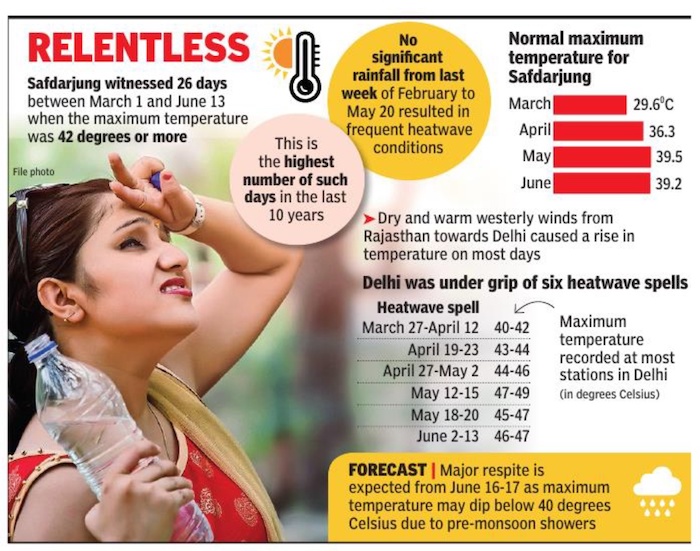
From: Priyangi Agarwal, June 14, 2022: The Times of India
New Delhi: Safdarjung witnessed 26 days when the maximum temperature was 42 degrees or more between March 1 and June 13. This is the highest number of such days in the past 10 years. Safdarjung, the city’s base weather station, saw 30 such days in 2012.
According to India Meteorological Department, the normal temperature for March, April, May and June for Safdarjung is 29. 6, 36. 3, 39. 5 and 39. 2 degrees Celsius, respectively. An official said a temperature of above 40 degrees Celsius raises discomfort.
Data from the Met department shows that just six and three such days were recorded in 2021 and 2020, respectively, between March 1 and June 30 when the maximum temperature was 42 degrees Celsius and above. No such day was reported in 1953, 1954 and 1971. IMD said the summer of 2010 saw the highest number of such days (35).
The capital recorded six spells of heatwave this year. RK Jenamani, senior scientist, IMD, said, “Summer 2022 in northwest India, including Delhi, uniquely started and progressed. As no significant rain was recorded from the last week of February till May 20, it led to dry conditions, resulting in frequent days with high temperature. ”
“Two active western distur- bances hit north India from May 22 to 30, giving respite from heatwave conditions. Rain helped surpass the normal mark of rainfall for the entire month of May. However, dry spell has again continued from June 1. The maximum temperature at Safdarjung has been above 42 degrees Celsius since June 3. The prolonged heatwave has affected people, plants and animals,” added Jenamani.
A major respite from heatwave conditions is expected on June 16-17. “The ongoing heatwave spell, which began from June 2, may be the last major one of this season. From June 16, heatwave is predicted to abate from northwest and central India, including Delhi-NCR. Pre-monsoon showers are expected from this week, which may bring down the temperature to below 40 degrees Celsius by June 16-17,” Jenamani said.
IMD has forecast the maximum temperature to be around 39 degrees Celsius on June 17, which may come down to 36 degrees Celsius on June 19. The maximum and minimum temperatures on Monday at Safdarjung was reported at 43. 7 and 31. 6 degrees Celsius, respectively. Both temperatures were four degrees above normal.
Region-wise
Delhi
The city recorded heatwaves in July in 2014, 2021.
Four heatwaves swept Delhi in a single year in 2014.
2010- May 2022
June 7, 2022: The Times of India
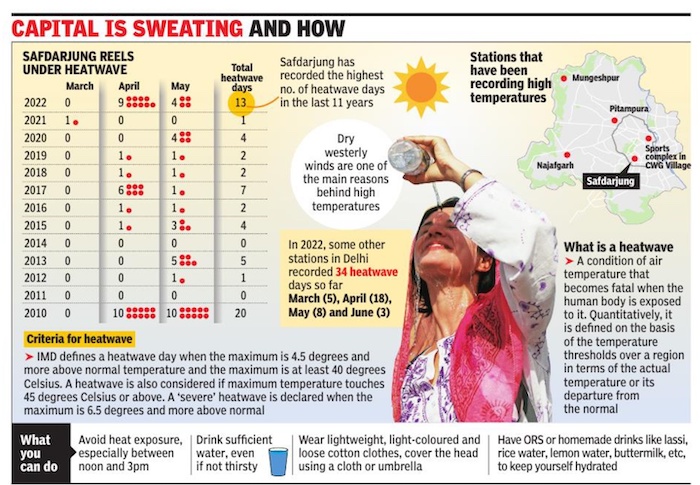
From: Priyangi Agarwal, June 7, 2022: The Times of India
New Delhi : This summer, Delhiites experienced the highest number of heatwave days in 12 years. While the city’s main weather station, Safdarjung, has recorded 13 heatwave days so far, some stations have logged as many as 34 since March, as per IMD, reports Priyangi Agarwal.
The last time Safdarjung recorded a higher number of heatwave days during the same period was 20 in 2010. The stations that have reported 34 such days till June 6 are all new installations for which historical data is not available. Of these 34 days, these stations recorded heatwave conditions on five days in March, 18 days in April, eight days in May and three days in June so far.
Deaths caused
2010-18
Heat waves killed over 6k since 2010, January 3, 2018: The Times of India
Over 6,100 people have died in India due to heat wave in the last nine years (2010-18) with the year 2015 alone recording nearly one-third such deaths. Among states, Andhra Pradesh had recorded the maximum casualties during 2013-15 period.
Analysis of the casualty figures shows that Andhra Pradesh, Telangana (after its formation in June, 2014), Odisha and West Bengal had together reported over 90% of total deaths due to heat wave during the period.
Sharing the nationwide cumulative figures in Lok Sabha, minister of earth sciences Harsh Vardhan on Wednesday said a latest study had showed that heat waves have increased in many parts of the country with these conditions being experienced generally during the period between March and July.
He, however, said the India Meteorological Department in collaboration with state health departments have started a heat action plan in many parts of the country as “an adaptive measure” to forewarn about heat waves and advise on preventive action to be taken. Figures show that 2,081 people had died due to heat wave in 2015.
2013-16

The Times of India, April 27, 2016
87 deaths take heatwave toll since 2013 to 4,204
As many as 87 people died between January and March 2016 owing to a heatwave, with the first three months of 2016 experiencing significantly abovenormal temperatures.
At 56, Telangana recorded the maximum casualties, followed by Odisha (19).Maharashtra, Tamil Nadu, Karnataka and Kerala witnessed one heatwave casualty each.
The deaths in 2013 take India's heatwave toll since 2013 to a staggering 4,204. In 2013, 2014 and 2015, heatwave killed 1,433, 549, and 2,135 peo ple, respectively. The figures were shared by earth sciences minister Y S Chowdary in the Lok Sabha on Wednesday in a written response to a question asked by over nine parliamentarians.
The number may go much higher if states do not take adequate precautionary me asures, as advised by IMD, in view of a forecast of higherthan-average temperatures for this year's summer (April-June). “Above normal heatwave conditions are very likely over central and north-west India during the 2016 hot weather season,“ Chowdary said.
2018
Sushmi Dey, ’31k heat-related deaths of 65+ in India in 2018’, December 3, 2020: The Times of India
India reported over 31,000 heat-related deaths of people older than 65 years in 2018, the second highest in the world after China (62,000), a new Lancet Countdown report on health and climate change shows, reports Sushmi Dey.
While heat-related mortality among people above 65 has increased by 53.7% globally during the past 20 years, it more than doubled in India. Globally, 2,96,000 deaths among the age group were reported in 2018.
The report shows India accounted for highest productivity loss at 40% of the total 302 billion work hours lost during 2019.
India’s agriculture sector among worst-affected by heat: Report
The report underlines that livelihoods are at risk because heat is increasingly affecting people’s ability to work outdoors in developing regions with significant economic implications. “India and Indonesia were among the worst affected countries, seeing losses of potential labour capacity equivalent to 4-6% of their annual gross domestic product,” it says. The report highlights that India’s agriculture sector was among the worst affected.
“The pandemic has shown us that when health is threatened on a global scale, our economies and ways of life can come to a standstill,” Dr Ian Hamilton, executive director of Lancet Countdown, said. “The threats to human health are multiplying and intensifying due to climate change and unless we change course, our healthcare systems are at risk of being overwhelmed in the future.”
In 2019, India saw a record number of above-baseline days of heatwave exposure affecting people aged over 65. Eight of the 10 highest ranking years of heatwave exposure in India have occurred since 2010. “The changing climate has downstream effects, impacting broader environmental systems, which in turn harm human health,” says the report.
Impact on health
2012-16: 40m additional Indians affected
‘Heatwaves hit 40m more Indians in 5 yrs’, November 29, 2018: The Times of India
Climate change is hitting home. India saw an increase of 40 million in the number of people exposed to heatwaves from 2012 to 2016 (counting both years), a global report prepared by 27 leading academic institutions, the United Nations and inter-governmental agencies has said.
The surge in heatwaves in India posed a major danger to health and called for urgent action to develop and implement local heat action plans, according to the study.
The Lancet Countdown report on health and climate change, released on Wednesday, said average temperatures in India are projected to rise alarmingly. Between 1901 and 2007, India’s mean temperature rose by more than 0.5 degree Celsius. “While the world is bracing for an increase of around 2 degrees C over the 21st century, northern, central and western India may witness increases averaging 2.2 to 5.5 degrees by the end of the 21st century,” it said.
Heatwaves tied to exacerbation of heart failure, kidney injury
Globally, the Lancet report said, vulnerability to extremes of heat has steadily risen since 1990 in every region, with 157 million more people exposed to heatwaves in 2017 as compared to 2000.
The average person experienced an additional 1.4 days of heatwaves per year over the same period, it said. Low- and middleincome countries, India included, are likely to be worst affected by climate change, given weaker health systems and poorer infrastructure, experts said.
Heatwaves are associated with increased rates of heat stress and heat stroke, exacerbation of heart failure and acute kidney injury from dehydration. Children, the elderly and those with pre-existing morbidities are particularly vulnerable.
Dr K Srinath Reddy, an author of the India policy brief of the Lancet report, said identifying local heat hot spots through appropriate tracking and modelling of meteorological data is needed tackle the crisis.
“Ahmedabad Municipal Corporation has adopted a heat action plan, which necessitates measures such as building heat shelters, ensuring availability of water and removing neonatal ICU from the top floor of hospitals. It has helped bring down the impact of heatwave of vulnerable population. Similar action plan should be developed by other states also,” said Dr Reddy, who is also head of the Public Health Foundation of India.
The Lancet report shows 153 billion hours of labour were lost globally in 2017 due to heat, an increase of 62 billion hours relative to year 2000. The impacts, the authors on India policy brief note, vary with different sectors with the agriculture being most vulnerable as compared to the industrial and services sector.
“For India, whose large agriculture economy makes up 18% of the country’s GDP and employs nearly half the population, this translates into substantial climate-related impacts on the workforce and economy,” said Dr Reddy.
Overall, India lost nearly 75,000 million hours of labour in 2017, relative to about 43,000 million hours in 2000, an increase of over 30,000 million hours over two decades. “For a developing economy like India, this represents a substantial impact on individual, household and national budgets, necessitating urgent national and regional adaptation plans,” the report said.
Impact of heat on productivity
1995
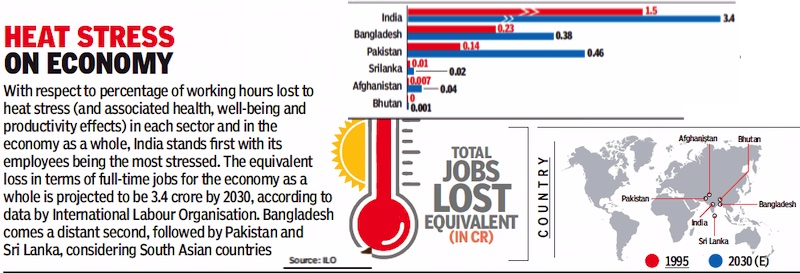
From: July 5, 2019: The Times of India
See graphic, ' The impact of heat on productivity in Afghanistan, Bhutan, Bangladesh, India, Pakistan, Sri Lanka/ 1995 '
